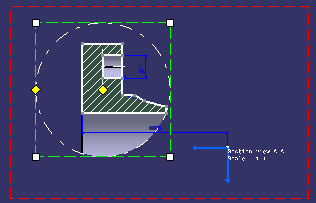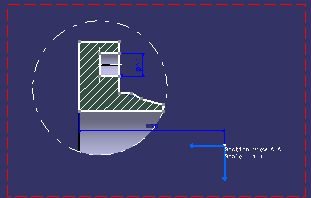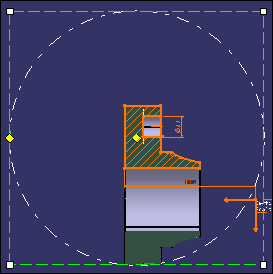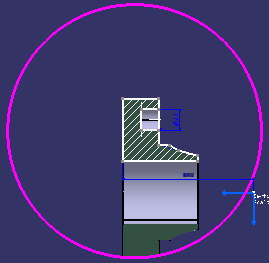-
Right-click the section view in the specification tree or in the sheet and select Clipping > Clip View.
The Tools Palette is displayed with circular and polygonal profile options.
You can either select Circular profile or Polygonal profile.
-
On selecting Circular profile, the radius definition dialog box is displayed allowing you to enter the radius.

-
Click in the geometry to select the circle center.
-
Enter the radius in the Tools Palette and press Enter or drag the radius on the sheet.
-
-
On selecting Polygonal profile, the length and angle definition box is displayed.

-
Click in the geometry to select the first point.
-
Draw the profile as needed.
-
Double click or select the first point to end the profile creation.

After selecting Clipping > Clip View, you can also select the Circular profile or Polygonal profile using the contextual menu (right-click in geometry):

-
-
-
Select the Circular profile in this case.
Click to select the circle center. Enter the radius in the Tools Palette or drag the radius on the sheet. Press Enter to validate the numeric value provided in the Tools Palette or click to validate the radius on the sheet.
The manipulators are activated so that you can make modifications to the clipping profile if needed.
-
To manipulate the control points, drag the yellow manipulators.
-
To resize the profile drag, the white manipulators.
-
To move the entire profile drag, the frame itself using one of its green dotted line.
-
-
Click again to validate the profile. You can see that the view is clipped.

-
Right-click the clipped view in the specification tree or geometry and select Clipping > Modify Clipping, to reframe, resize and/or move the clipping frame according to your design needs. The manipulators of the clipped profile are activated.

Drag the white manipulators to resize the profile. The green dotted circular profile shows the clipping that will be obtained after the manipulation.

- Clipping outline can be fully displayed or
invisible.
When displayed, the clipping outlines are also printed, and visualized in 3D (except if Hide in 3D option is selected). - Clipping outlines are non-selectable and therefore cannot be dimensioned or annotated.
- Visualization properties of clipping
outlines can be customized in two ways:
- For customizing after the clipped view creation, go to Edit > Properties or right-click the view and select Properties > Visualization tab, Clipping Outline area.
- For customizing global settings, go to Tools > Options > Mechanical Design > 2D Layout
for 3D Design, View Creation tab, Clipping
Outline area.
For more information, refer to View Creation > Clipping Outline.
- The visualization properties that can be
customized are:
- Display: Displays the clipping outline. By default, this option is selected.
- Color: By default, white color is selected.
- Line type (only among the first height linetypes): By default, linetype is 4.
- Thickness: By default,
thickness is 1.

Change the color and linetype of the clip profile.

- Clipping outline can be fully displayed or
invisible.
-
Right-click the clipped view in the specification tree or geometry, and select Clipping > Unclip View to unclip the existing profile.
-
Select Clipping > Replace Clipping from the contextual menu, to replace the existing clipping view.
The previous clipping is removed and a new clipping can be defined in the same way as when using the Clip View command. The graphic properties of the replaced profile are applied to the newly defined clipping profile.
-
If a clipping view is copied, the pasted view is a clipping view with the same profile as the copied view.
-
If a 2D layout view is created with the New View From command by selecting a clipping view, the new view is a clipping view in which the clipping profile is equivalent to the clipping profile of the reference view.
-
If a clipping view is rotated its profile is also rotated by the same angle.
If the view scale of a clipping view is modified, the position and size of the clipping profile are scaled too. -
When the clipped part is exported to a drawing, the representation of the generated clipping outline follows Generative Drafting options or Generative view styles, and thus may differ from 2D layout representation. If Tools > Options > Mechanical Design > Drafting > Administration tab, Generative view style area, Prevent generative view style usage option is cleared, you can select a predefined style when generating a single view or the default style (DefaultGenerativeStyle) is used when generating a full drawing. If Prevent generative view style usage option is selected, the linetype defined in Tools > Options > Mechanical Design > Drafting > View > View linetype is used.

- For pre-R18 2D layouts, where the view is not clipped, you can apply clipping to a view by using the Clip View command.
-
When pre-R18 2D layouts with a clipped view are exported to drafting and the drawing is updated, the representation of the generated clipping outline is also updated. The profile is updated as shown in the image:
Pre-R18 2D layout exported to drafting:
on updating drawing in R18:

The linetype used for clipping view in pre-R18 was of the breakout view. When exported to R18, the linetype used for clipping view depends on Generative Drafting options or Generative view styles, which is of detail view linetype.
![]()